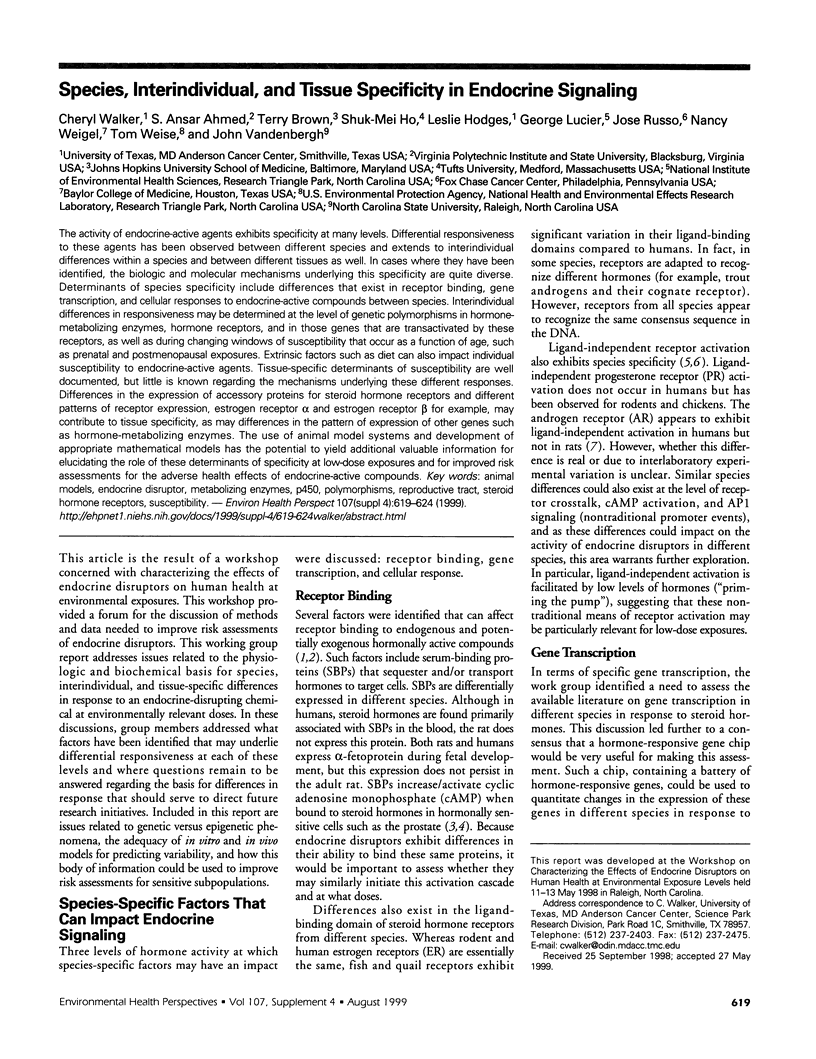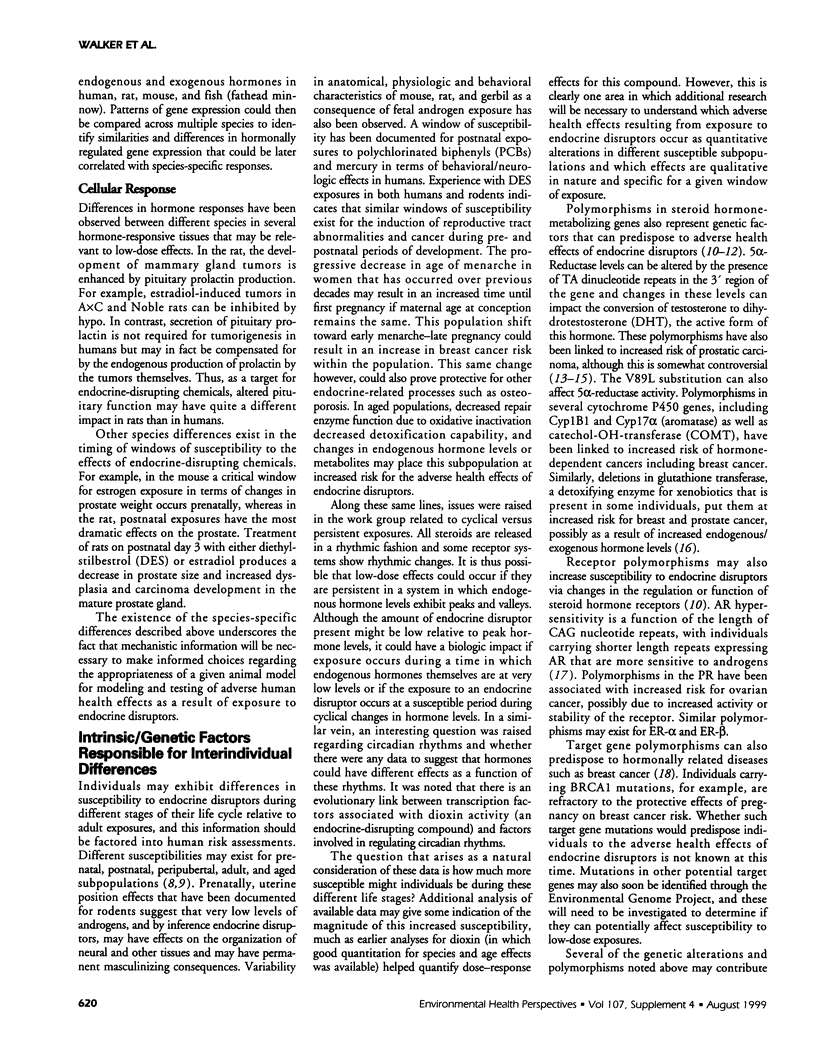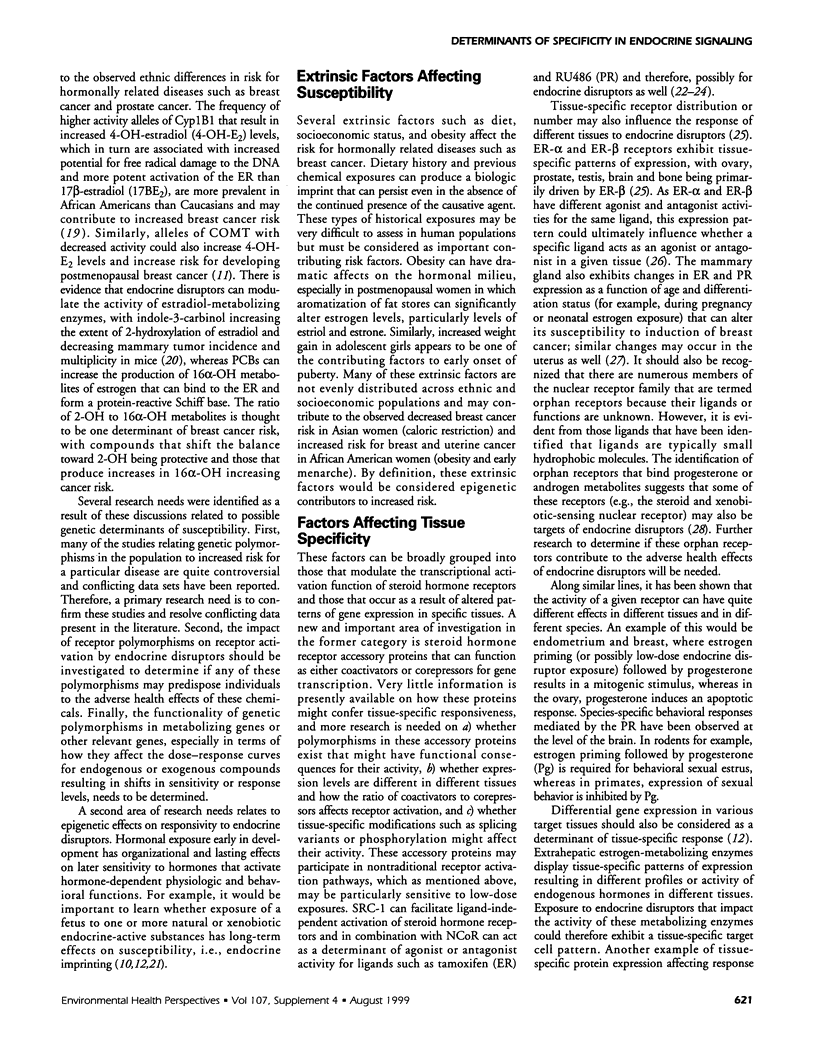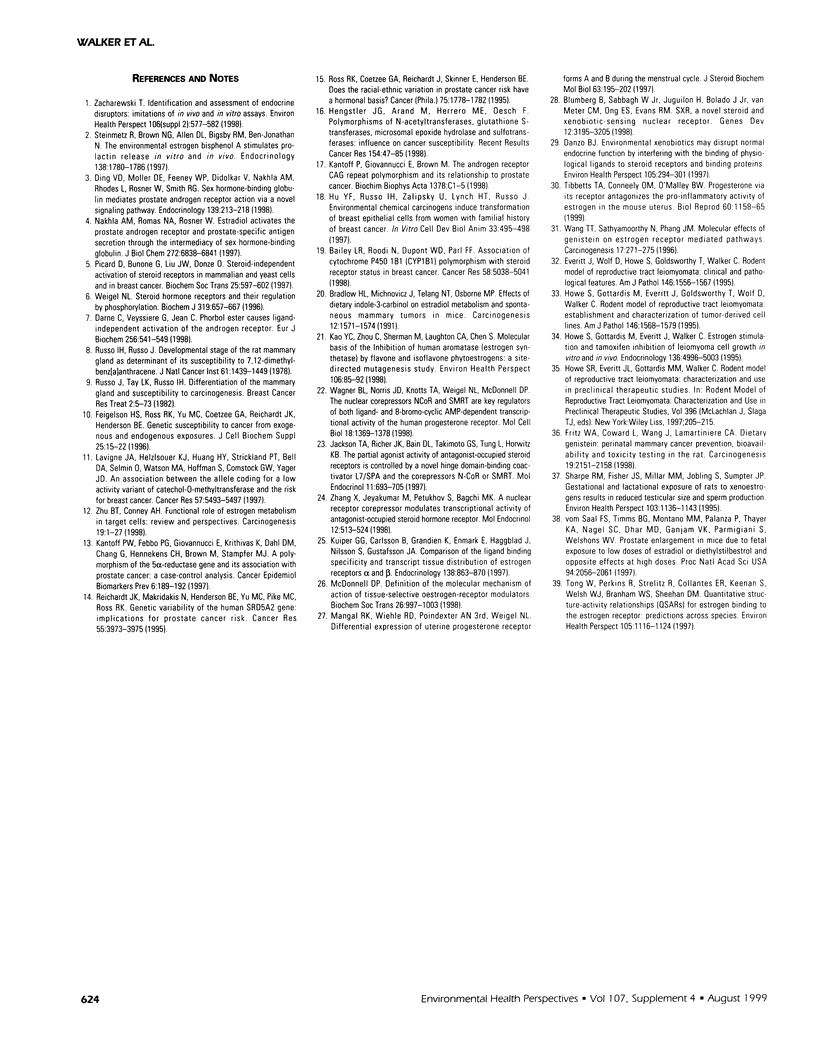Abstract
The activity of endocrine-active agents exhibits specificity at many levels. Differential responsiveness to these agents has been observed between different species and extends to interindividual differences within a species and between different tissues as well. In cases where they have been identified, the biologic and molecular mechanisms underlying this specificity are quite diverse. Determinants of species specificity include differences that exist in receptor binding, gene transcription, and cellular responses to endocrine-active compounds between species. Interindividual differences in responsiveness may be determined at the level of genetic polymorphisms in hormone-metabolizing enzymes, hormone receptors, and in those genes that are transactivated by these receptors, as well as during changing windows of susceptibility that occur as a function of age, such as prenatal and postmenopausal exposures. Extrinsic factors such as diet can also impact individual susceptibility to endocrine-active agents. Tissue-specific determinants of susceptibility are well documented, but little is known regarding the mechanisms underlying these different responses. Differences in the expression of accessory proteins for steroid hormone receptors and different patterns of receptor expression, estrogen receptor alpha and estrogen receptor beta; for example, may contribute to tissue specificity, as may differences in the pattern of expression of other genes such as hormone-metabolizing enzymes. The use of animal model systems and development of appropriate mathematical models has the potential to yield additional valuable information for elucidating the role of these determinants of specificity at low-dose exposures and for improved risk assessments for the adverse health effects of endocrine-active compounds.
Full text
PDF





Selected References
These references are in PubMed. This may not be the complete list of references from this article.
- Bailey L. R., Roodi N., Dupont W. D., Parl F. F. Association of cytochrome P450 1B1 (CYP1B1) polymorphism with steroid receptor status in breast cancer. Cancer Res. 1998 Nov 15;58(22):5038–5041. [PubMed] [Google Scholar]
- Blumberg B., Sabbagh W., Jr, Juguilon H., Bolado J., Jr, van Meter C. M., Ong E. S., Evans R. M. SXR, a novel steroid and xenobiotic-sensing nuclear receptor. Genes Dev. 1998 Oct 15;12(20):3195–3205. doi: 10.1101/gad.12.20.3195. [DOI] [PMC free article] [PubMed] [Google Scholar]
- Bradlow H. L., Michnovicz J., Telang N. T., Osborne M. P. Effects of dietary indole-3-carbinol on estradiol metabolism and spontaneous mammary tumors in mice. Carcinogenesis. 1991 Sep;12(9):1571–1574. doi: 10.1093/carcin/12.9.1571. [DOI] [PubMed] [Google Scholar]
- Danzo B. J. Environmental xenobiotics may disrupt normal endocrine function by interfering with the binding of physiological ligands to steroid receptors and binding proteins. Environ Health Perspect. 1997 Mar;105(3):294–301. doi: 10.1289/ehp.97105294. [DOI] [PMC free article] [PubMed] [Google Scholar]
- Darne C., Veyssiere G., Jean C. Phorbol ester causes ligand-independent activation of the androgen receptor. Eur J Biochem. 1998 Sep 15;256(3):541–549. doi: 10.1046/j.1432-1327.1998.2560541.x. [DOI] [PubMed] [Google Scholar]
- Ding V. D., Moller D. E., Feeney W. P., Didolkar V., Nakhla A. M., Rhodes L., Rosner W., Smith R. G. Sex hormone-binding globulin mediates prostate androgen receptor action via a novel signaling pathway. Endocrinology. 1998 Jan;139(1):213–218. doi: 10.1210/endo.139.1.5681. [DOI] [PubMed] [Google Scholar]
- Everitt J. I., Wolf D. C., Howe S. R., Goldsworthy T. L., Walker C. Rodent model of reproductive tract leiomyomata. Clinical and pathological features. Am J Pathol. 1995 Jun;146(6):1556–1567. [PMC free article] [PubMed] [Google Scholar]
- Feigelson H. S., Ross R. K., Yu M. C., Coetzee G. A., Reichardt J. K., Henderson B. E. Genetic susceptibility to cancer from exogenous and endogenous exposures. J Cell Biochem Suppl. 1996;25:15–22. doi: 10.1002/(sici)1097-4644(1996)25+<15::aid-jcb2>3.0.co;2-5. [DOI] [PubMed] [Google Scholar]
- Fritz W. A., Coward L., Wang J., Lamartiniere C. A. Dietary genistein: perinatal mammary cancer prevention, bioavailability and toxicity testing in the rat. Carcinogenesis. 1998 Dec;19(12):2151–2158. doi: 10.1093/carcin/19.12.2151. [DOI] [PubMed] [Google Scholar]
- Hengstler J. G., Arand M., Herrero M. E., Oesch F. Polymorphisms of N-acetyltransferases, glutathione S-transferases, microsomal epoxide hydrolase and sulfotransferases: influence on cancer susceptibility. Recent Results Cancer Res. 1998;154:47–85. doi: 10.1007/978-3-642-46870-4_4. [DOI] [PubMed] [Google Scholar]
- Howe S. R., Gottardis M. M., Everitt J. I., Goldsworthy T. L., Wolf D. C., Walker C. Rodent model of reproductive tract leiomyomata. Establishment and characterization of tumor-derived cell lines. Am J Pathol. 1995 Jun;146(6):1568–1579. [PMC free article] [PubMed] [Google Scholar]
- Howe S. R., Gottardis M. M., Everitt J. I., Walker C. Estrogen stimulation and tamoxifen inhibition of leiomyoma cell growth in vitro and in vivo. Endocrinology. 1995 Nov;136(11):4996–5003. doi: 10.1210/endo.136.11.7588234. [DOI] [PubMed] [Google Scholar]
- Hu Y. F., Russo I. H., Zalipsky U., Lynch H. T., Russo J. Environmental chemical carcinogens induce transformation of breast epithelial cells from women with familial history of breast cancer. In Vitro Cell Dev Biol Anim. 1997 Jul-Aug;33(7):495–498. doi: 10.1007/s11626-997-0090-6. [DOI] [PubMed] [Google Scholar]
- Jackson T. A., Richer J. K., Bain D. L., Takimoto G. S., Tung L., Horwitz K. B. The partial agonist activity of antagonist-occupied steroid receptors is controlled by a novel hinge domain-binding coactivator L7/SPA and the corepressors N-CoR or SMRT. Mol Endocrinol. 1997 Jun;11(6):693–705. doi: 10.1210/mend.11.6.0004. [DOI] [PubMed] [Google Scholar]
- Kantoff P. W., Febbo P. G., Giovannucci E., Krithivas K., Dahl D. M., Chang G., Hennekens C. H., Brown M., Stampfer M. J. A polymorphism of the 5 alpha-reductase gene and its association with prostate cancer: a case-control analysis. Cancer Epidemiol Biomarkers Prev. 1997 Mar;6(3):189–192. [PubMed] [Google Scholar]
- Kantoff P., Giovannucci E., Brown M. The androgen receptor CAG repeat polymorphism and its relationship to prostate cancer. Biochim Biophys Acta. 1998 Nov 26;1378(3):C1–C5. doi: 10.1016/s0304-419x(98)00023-7. [DOI] [PubMed] [Google Scholar]
- Kao Y. C., Zhou C., Sherman M., Laughton C. A., Chen S. Molecular basis of the inhibition of human aromatase (estrogen synthetase) by flavone and isoflavone phytoestrogens: A site-directed mutagenesis study. Environ Health Perspect. 1998 Feb;106(2):85–92. doi: 10.1289/ehp.9810685. [DOI] [PMC free article] [PubMed] [Google Scholar]
- Kuiper G. G., Carlsson B., Grandien K., Enmark E., Häggblad J., Nilsson S., Gustafsson J. A. Comparison of the ligand binding specificity and transcript tissue distribution of estrogen receptors alpha and beta. Endocrinology. 1997 Mar;138(3):863–870. doi: 10.1210/endo.138.3.4979. [DOI] [PubMed] [Google Scholar]
- Lavigne J. A., Helzlsouer K. J., Huang H. Y., Strickland P. T., Bell D. A., Selmin O., Watson M. A., Hoffman S., Comstock G. W., Yager J. D. An association between the allele coding for a low activity variant of catechol-O-methyltransferase and the risk for breast cancer. Cancer Res. 1997 Dec 15;57(24):5493–5497. [PubMed] [Google Scholar]
- Mangal R. K., Wiehle R. D., Poindexter A. N., 3rd, Weigel N. L. Differential expression of uterine progesterone receptor forms A and B during the menstrual cycle. J Steroid Biochem Mol Biol. 1997 Nov-Dec;63(4-6):195–202. doi: 10.1016/s0960-0760(97)00119-2. [DOI] [PubMed] [Google Scholar]
- Nakhla A. M., Romas N. A., Rosner W. Estradiol activates the prostate androgen receptor and prostate-specific antigen secretion through the intermediacy of sex hormone-binding globulin. J Biol Chem. 1997 Mar 14;272(11):6838–6841. doi: 10.1074/jbc.272.11.6838. [DOI] [PubMed] [Google Scholar]
- Picard D., Bunone G., Liu J. W., Donzé O. Steroid-independent activation of steroid receptors in mammalian and yeast cells and in breast cancer. Biochem Soc Trans. 1997 May;25(2):597–602. doi: 10.1042/bst0250597. [DOI] [PubMed] [Google Scholar]
- Reichardt J. K., Makridakis N., Henderson B. E., Yu M. C., Pike M. C., Ross R. K. Genetic variability of the human SRD5A2 gene: implications for prostate cancer risk. Cancer Res. 1995 Sep 15;55(18):3973–3975. [PubMed] [Google Scholar]
- Russo I. H., Russo J. Developmental stage of the rat mammary gland as determinant of its susceptibility to 7,12-dimethylbenz[a]anthracene. J Natl Cancer Inst. 1978 Dec;61(6):1439–1449. [PubMed] [Google Scholar]
- Russo J., Tay L. K., Russo I. H. Differentiation of the mammary gland and susceptibility to carcinogenesis. Breast Cancer Res Treat. 1982;2(1):5–73. doi: 10.1007/BF01805718. [DOI] [PubMed] [Google Scholar]
- Sharpe R. M., Fisher J. S., Millar M. M., Jobling S., Sumpter J. P. Gestational and lactational exposure of rats to xenoestrogens results in reduced testicular size and sperm production. Environ Health Perspect. 1995 Dec;103(12):1136–1143. doi: 10.1289/ehp.951031136. [DOI] [PMC free article] [PubMed] [Google Scholar]
- Steinmetz R., Brown N. G., Allen D. L., Bigsby R. M., Ben-Jonathan N. The environmental estrogen bisphenol A stimulates prolactin release in vitro and in vivo. Endocrinology. 1997 May;138(5):1780–1786. doi: 10.1210/endo.138.5.5132. [DOI] [PubMed] [Google Scholar]
- Tibbetts T. A., Conneely O. M., O'Malley B. W. Progesterone via its receptor antagonizes the pro-inflammatory activity of estrogen in the mouse uterus. Biol Reprod. 1999 May;60(5):1158–1165. doi: 10.1095/biolreprod60.5.1158. [DOI] [PubMed] [Google Scholar]
- Tong W., Perkins R., Strelitz R., Collantes E. R., Keenan S., Welsh W. J., Branham W. S., Sheehan D. M. Quantitative structure-activity relationships (QSARs) for estrogen binding to the estrogen receptor: predictions across species. Environ Health Perspect. 1997 Oct;105(10):1116–1124. doi: 10.1289/ehp.971051116. [DOI] [PMC free article] [PubMed] [Google Scholar]
- Wagner B. L., Norris J. D., Knotts T. A., Weigel N. L., McDonnell D. P. The nuclear corepressors NCoR and SMRT are key regulators of both ligand- and 8-bromo-cyclic AMP-dependent transcriptional activity of the human progesterone receptor. Mol Cell Biol. 1998 Mar;18(3):1369–1378. doi: 10.1128/mcb.18.3.1369. [DOI] [PMC free article] [PubMed] [Google Scholar]
- Wang T. T., Sathyamoorthy N., Phang J. M. Molecular effects of genistein on estrogen receptor mediated pathways. Carcinogenesis. 1996 Feb;17(2):271–275. doi: 10.1093/carcin/17.2.271. [DOI] [PubMed] [Google Scholar]
- Weigel N. L. Steroid hormone receptors and their regulation by phosphorylation. Biochem J. 1996 Nov 1;319(Pt 3):657–667. doi: 10.1042/bj3190657. [DOI] [PMC free article] [PubMed] [Google Scholar]
- Zacharewski T. Identification and assessment of endocrine disruptors: limitations of in vivo and in vitro assays. Environ Health Perspect. 1998 Apr;106 (Suppl 2):577–582. doi: 10.1289/ehp.98106577. [DOI] [PMC free article] [PubMed] [Google Scholar]
- Zhang X., Jeyakumar M., Petukhov S., Bagchi M. K. A nuclear receptor corepressor modulates transcriptional activity of antagonist-occupied steroid hormone receptor. Mol Endocrinol. 1998 Apr;12(4):513–524. doi: 10.1210/mend.12.4.0089. [DOI] [PubMed] [Google Scholar]
- Zhu B. T., Conney A. H. Functional role of estrogen metabolism in target cells: review and perspectives. Carcinogenesis. 1998 Jan;19(1):1–27. doi: 10.1093/carcin/19.1.1. [DOI] [PubMed] [Google Scholar]
- vom Saal F. S., Timms B. G., Montano M. M., Palanza P., Thayer K. A., Nagel S. C., Dhar M. D., Ganjam V. K., Parmigiani S., Welshons W. V. Prostate enlargement in mice due to fetal exposure to low doses of estradiol or diethylstilbestrol and opposite effects at high doses. Proc Natl Acad Sci U S A. 1997 Mar 4;94(5):2056–2061. doi: 10.1073/pnas.94.5.2056. [DOI] [PMC free article] [PubMed] [Google Scholar]


